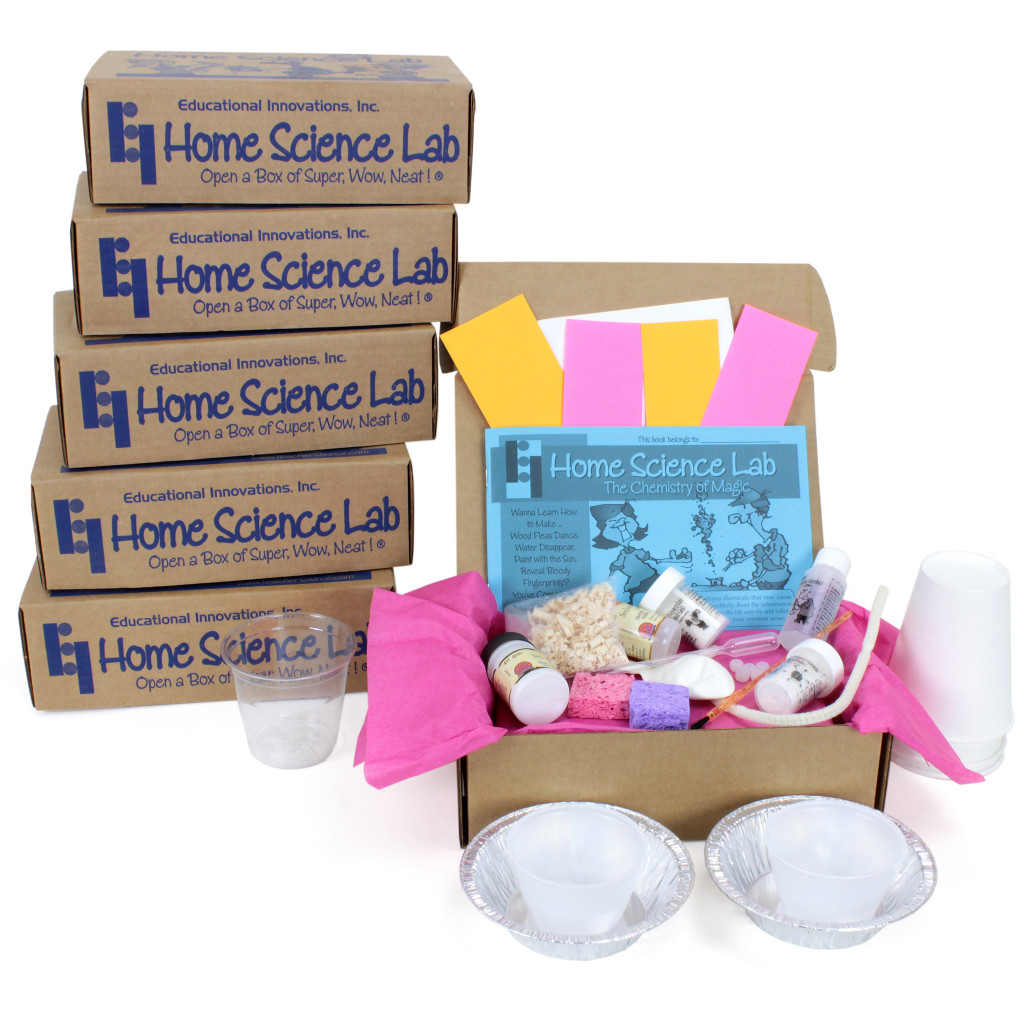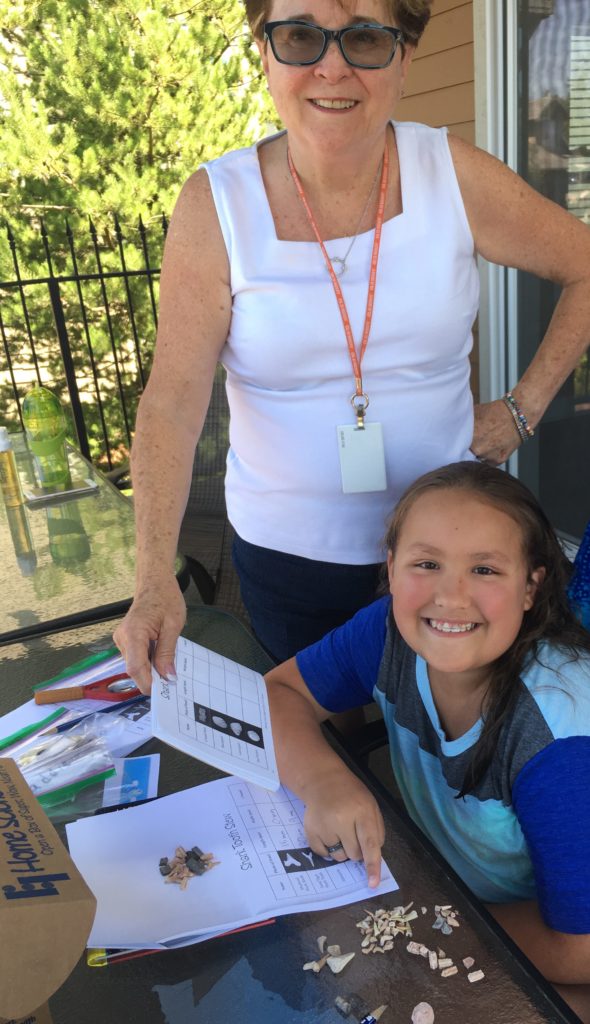Dinosaurs inspire curiosity and wonder in scientists of all ages. With the help of Educational Innovations’ Home Science Lab: Tabletop Fossil Safari, young learners can conduct investigations at home to dynamically discover how fossils were created millions of years ago, and to better understand how they continue to be unearthed by paleontologists today. Everything you need comes in the nifty Home Science Lab box: six activities organized in a booklet filled with easy-to-follow instructions, whimsical illustrations and photographs, assorted chemicals, household items, and of course, real fossils!
It’s so easy, even a grandmother can do it. Seriously!
Last summer my friends Ann, Carolyn, Sunnie and I were pondering what to do with our five grandchildren (ages 5-13). How could we make the most of our precious time together? I suggested we plan a weekly Summer Science Camp. I ordered the Home Science Lab kit and soon enough, we ventured where no grandparents had gone before.
What occurred in the weeks that followed was an unforgettable collaborative learning experience. All of the children were fully engaged. The older ones enjoyed “being the teacher” and helping the little ones. Everyone had a job and everyone had fun—even the grandmas!
Each week, a new fossil theme and related activities filled the afternoon with excitement and adventure. Our grandchildren may not have realized it, but as they participated in our little camp, they were reinforcing solid study skills such as increasing their reading comprehension, following directions, making measurements, collecting and organizing data, performing mathematical calculations, and making predictions—not to mention the fact that they were building totally cool projects!
Week 1: “Fossils Casts & Dino Tracks” and “Searchin’ for Urchins”
Our first week we did the first two activities in the kit. With “Fossil Casts & Dino Tracks,” we learned how cast and mold fossils are formed. The kids stamped their own fossils in clay and then filled the molds with plaster of Paris to create fossil casts. Some children walked small toy dinosaurs across the clay to make trace fossils. We wondered how scientists use the information they gather from trace fossils to understand and even reconstruct prehistoric animals. In “Searchin’ for Urchins,” our campers got a chance to create their own prehistoric sea urchins, using real sea urchin fossils as their guide.
Week 2: “Oyster Line Up” and “Petrified Wood & Bone”
The activity called “Oyster Line Up” required the children to make measurements and gather data about the oyster fossils supplied in their kit. Hoping to help the kids realize that even now we are surrounded by “living fossils”—modern ancestors of extinct organisms—I brought in a live oyster and clam for comparison. We dissected them to reveal the hard and soft body parts of the animals, thus reinforcing the prior week’s lesson: that only the hard parts of the animal usually become a fossil.
From there, we moved onto “Petrified Wood & Bone,” which introduced us to the process of permineralization. Our campers poured a sodium silicate solution over a sponge to replicate the way mineral-rich ground water is absorbed by the soft tissue of plants and animals. They made predictions and were eager to return the following week to see their “fossil.” We pretended that our seven-day gap would be seven million years. The “Aha!” moment arose when they returned a week later and found their sponge had turned rock hard, just like the kit’s ancient fossil samples.
Week 3: “Squished Fish” and “Shark Tooth Stew”
The kit’s “Squished Fish” fossil sample totally intrigued the kids. They used a hand lens to make detailed observations. They followed the instructions to make pencil rubbings that transferred the fish image onto paper. This was a great way to point out that important scientific research can occur out in the field, not just in a lab setting.
The final activity was a marine fossil extravaganza entitled “Shark Tooth Stew.” Working in teams, the kids sorted and identified eight different fossils from a generous collection. They made measurements, collected data, and organized their information on a chart. They made guesses as to how the fossils may have been formed, utilizing knowledge they’d learned during previous activities. By the time they were done, they certainly demonstrated a better understanding of the fossilization processes and the analytical work of paleontologists.
“Fossil Pendant Craft Project”
I wanted everyone to take a little piece of Summer Science Camp home, so I decided to create a wearable art project using common craft materials. All the children and grandmothers picked their favorite fossils to construct their own pendants.
As they examined their fossils with the hand lens, the children’s comments showed their appreciation for the texture, shape, and function of their chosen fossil. Boys and girls alike were excited to transform the scientific artifact in wearable art.
Materials:
1 fossil
3 inches of fine jewelry wire
2-3 feet of colorful silk cord (or rawhide cord)
super glue
needle-nose pliers
Directions:
Gently wrap the wire around the fossil.
Create and twist a loop at the top.
Add a small dab of super glue to secure the wire and fossil.
Thread the cord through the loop and knot the ends together.
My big takeaway from these weeks shared with my friends and their grandchildren was the joy, anticipation, and excitement of the activities. It was my first time using the Home Science Lab—and it was a huge success. When we finished the art project, my grandson Henry spoke up. “Nana! What are we all doing next week at Summer Science Camp?” Other eager eyes looked to their grandmothers and to me. Little did they know, but the next Home Science Lab kit was on the way…..but that’s another story!
FINAL NOTE: I believe the Tabletop Fossil Safari could easily be adapted for a home school situation or even guide a classroom teacher with the scope and sequence of lesson ideas.








Did you purchase a kit for each child or we’re multiple children able to do the activities contained in one kit?
Only one kit was purchased. I feel this was adequate for the 8 children doing the camp.
The children shared the mineralization lab. Two “fossil sponges” were made. Some children did the mixing/pouring of the solution, others looked on. Two sponges were available for hands on observations at the following camp session.
For all the other activities they worked in pairs. I made copies of the data sheets, utilized extra hand lenses I own, so each group was equipped. There is a generous amount of fossils in the kit to share.
~Priscilla Robinson